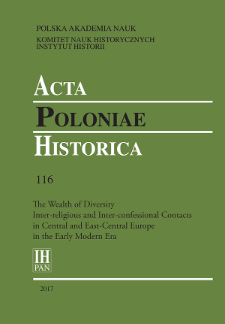- Wyszukaj w całym Repozytorium
- Piśmiennictwo i mapy
- Archeologia
- Baza Młynów
- Nauki przyrodnicze
Wyszukiwanie zaawansowane
Wyszukiwanie zaawansowane
Wyszukiwanie zaawansowane
Wyszukiwanie zaawansowane
Wyszukiwanie zaawansowane

Obiekt
Tytuł: Court Chapels in Saxony between 1697 and 1733: Augustus II the Strong between Catholicism and Protestantism
Inny tytuł:
Acta Poloniae Historica T. 116 (2017) ; The Wealth of Diversity Inter-religious and Inter-confessional Contacts in Central and East-Central Europe in the Early Modern Era
Współtwórca:
Hyatt, Francesca : Red. ; Instytut Historii Polskiej Akademii Nauk ; Komitet Nauk Historycznych Polskiej Akademii Nauk
Wydawca:
Instytut Historii Polskiej Akademii Nauk
Miejsce wydania:
Opis:
Typ obiektu:
Abstrakt:
When Augustus II the Strong (1670–1733) converted from the Protestant to the Catholic confession, he guaranteed his subjects – all Lutheran – the free exercise of their religion and belief. He also respected their wish not to allow the ‘new’ old confession emerge too overtly in the motherland of Martin Luther and the Reformation. Consequently, the Catholic chapels he built during his reign in Saxony were constructed in private in order to assure the peaceful co-existence of the confessions. What may appear to be a tolerant religious policy was in fact almost the contrary: This article will briefly illuminate the historical and political background of Augustus’ decisions, while the main focus will be to examine the newly installed Catholic court chapels.
Bibliografia:
Christ Günther, ‘Fürst, Dynastie, Territorium und Konfession’, Saeculum, xxiv (1973), 367–87.
Finger Birgit, ‘Die Schlosskapelle von Pillnitz’, Jahrbuch der Staatlichen Schlösser, Burgen und Gärten in Sachsen, vi (1998), 60–74.
Fitschen Klaus, ‘Der Glaubenswechsel Augusts des Starken im Spannungsfeld toleranzund konfessionspolitischer Probleme’, in Frank-Lothar Kroll and Hendrik Thoß (eds.), Zwei Staaten, eine Krone. Die polnisch-sächsische Union 1697–1763 (Berlin, 2016), 165–74.
Gierowski Józef A., ‘Personaloder Realunion?’, in Johannes Kalisch and Józef A. Gierowski, Um die polnische Krone. Sachsen und Polen während des Nordischen Krieges 1700–1721 (Berlin, 1962), 254–91.
Gierowski Józef A., ‘Die sächsisch-polnische Personalunion als Problem des Monarchen aus polnischer Sicht’, in Rex Rexheuser (ed.), Die Personalunionen von Sachsen-Polen 1697–1763 und Hannover-England 1714–1837 (Wiesbaden, 2005), 121–52.
Hartmann Hans-Günther, Moritzburg. Schloß und Umgebung in Geschichte und Gegenwart (Weimar, 1990).
Kretschmann Iris, Schlosskapelle Moritzburg (München, 1991).
Magirius Heinrich, Die evangelische Schlosskapelle zu Dresden aus kunstgeschichtlicher Sicht (Altenburg, 2009).
Meier Esther, Sakralkunst am Hof zu Dresden. Kontext als Prozess (Berlin, 2015).
Mitzscherlich Birgit, ‘Der Neubeginn des Katholizismus in Leipzig im 18. Jahrhundert’, in Enno Bünz (ed.), Das religiöse Leipzig (Leipzig, 2013), 237–55.
Saft Paul F., Der Neuaufbau der katholischen Kirche in Sachsen im 18. Jahrhundert (Leipzig, 1961).
Seifert Siegfried, Niedergang und Wiederaufstieg der katholischen Kirche in Sachsen (Leipzig, 1964).
Staszewski Jacek, ‘Begründung und Fortsetzung der Personalunion Sachsen-Polen 1697 und 1733’, in Rex Rexheuser (ed.), Die Personalunionen von Sachsen-Polen 1697–1763 und Hannover-England 1714–1837 (Wiesbaden, 2005), 37–50.
Staszewski Jacek, ‘Die unterbrochene sächsisch-polnische Union nach dem Frieden von Altranstädt und vor Wiederkehr Augusts II. auf den polnischen Thron (1706–1709)’, in Jürgen R. Wolf (ed.), 1707–2007 Altranstädter Konvention. Ein Meilenstein religiöser Toleranz in Europa (Halle, 2008), 51–7.
Tazbir Janusz, Geschichte der polnischen Toleranz (Warszawa, 1977).
Vötsch Jochen, Kursachsen, das Reich und der mitteldeutsche Raum zu Beginn des 18. Jahrhunderts (Frankfurt, 2003).
Czasopismo/Seria/cykl:
Tom:
Strona pocz.:
Strona końc.:
Szczegółowy typ zasobu:
Format:
Identyfikator zasobu:
oai:rcin.org.pl:68566 ; 0001-6829 ; 10.12775/APH.2017.116.04
Źródło:
IH PAN, sygn. A.295/116 Podr. ; IH PAN, sygn. A.296/116 ; kliknij tutaj, żeby przejść
Język:
Prawa:
Licencja Creative Commons Uznanie autorstwa-Użycie niekomercyjne-Bez utworów zależnych 4.0
Zasady wykorzystania:
Zasób chroniony prawem autorskim. [CC BY-ND 4.0 Międzynarodowe] Korzystanie dozwolone zgodnie z licencją Creative Commons Uznanie autorstwa-Bez utworów zależnych 4.0, której pełne postanowienia dostępne są pod adresem: ; -
Digitalizacja:
Instytut Historii Polskiej Akademii Nauk
Lokalizacja oryginału:
Biblioteka Instytutu Historii PAN
Dofinansowane ze środków:
Dostęp:
Kolekcje, do których przypisany jest obiekt:
- Repozytorium Cyfrowe Instytutów Naukowych > Kolekcje Partnerów > Instytut Historii PAN > Czasopisma
- Repozytorium Cyfrowe Instytutów Naukowych > Kolekcje Partnerów > Instytut Historii PAN > Wydawnictwa Instytutu
- Repozytorium Cyfrowe Instytutów Naukowych > Kolekcje Partnerów > Instytut Historii PAN > Wydawnictwa Instytutu > Czasopisma
- Repozytorium Cyfrowe Instytutów Naukowych > Kolekcje Partnerów > Instytut Historii PAN > Wydawnictwa Instytutu > Czasopisma > Acta Poloniae Historica
- Repozytorium Cyfrowe Instytutów Naukowych > Piśmiennictwo > Czasopisma/Artykuły
Data ostatniej modyfikacji:
22 wrz 2023
Data dodania obiektu:
18 lut 2019
Liczba pobrań / odtworzeń:
394
Wszystkie dostępne wersje tego obiektu:
https://rcin.org.pl./publication/85770
Wyświetl opis w formacie RDF:
Wyświetl opis w formacie RDFa:
Wyświetl opis w formacie OAI-PMH:
Obiekty Podobne
Kosińska, Urszula
Kosińska, Urszula
Kosińska, Urszula
Kriegseisen, Wojciech (1955– )
Bela, Zbigniew (1949– )
Kosińska, Urszula

 INSTYTUT ARCHEOLOGII I ETNOLOGII POLSKIEJ AKADEMII NAUK
INSTYTUT ARCHEOLOGII I ETNOLOGII POLSKIEJ AKADEMII NAUK
 INSTYTUT BADAŃ LITERACKICH POLSKIEJ AKADEMII NAUK
INSTYTUT BADAŃ LITERACKICH POLSKIEJ AKADEMII NAUK
 INSTYTUT BADAWCZY LEŚNICTWA
INSTYTUT BADAWCZY LEŚNICTWA
 INSTYTUT BIOLOGII DOŚWIADCZALNEJ IM. MARCELEGO NENCKIEGO POLSKIEJ AKADEMII NAUK
INSTYTUT BIOLOGII DOŚWIADCZALNEJ IM. MARCELEGO NENCKIEGO POLSKIEJ AKADEMII NAUK
 INSTYTUT BIOLOGII SSAKÓW POLSKIEJ AKADEMII NAUK
INSTYTUT BIOLOGII SSAKÓW POLSKIEJ AKADEMII NAUK
 INSTYTUT CHEMII FIZYCZNEJ PAN
INSTYTUT CHEMII FIZYCZNEJ PAN
 INSTYTUT CHEMII ORGANICZNEJ PAN
INSTYTUT CHEMII ORGANICZNEJ PAN
 INSTYTUT FILOZOFII I SOCJOLOGII PAN
INSTYTUT FILOZOFII I SOCJOLOGII PAN
 INSTYTUT GEOGRAFII I PRZESTRZENNEGO ZAGOSPODAROWANIA PAN
INSTYTUT GEOGRAFII I PRZESTRZENNEGO ZAGOSPODAROWANIA PAN
 INSTYTUT HISTORII im. TADEUSZA MANTEUFFLA POLSKIEJ AKADEMII NAUK
INSTYTUT HISTORII im. TADEUSZA MANTEUFFLA POLSKIEJ AKADEMII NAUK
 INSTYTUT JĘZYKA POLSKIEGO POLSKIEJ AKADEMII NAUK
INSTYTUT JĘZYKA POLSKIEGO POLSKIEJ AKADEMII NAUK
 INSTYTUT MATEMATYCZNY PAN
INSTYTUT MATEMATYCZNY PAN
 INSTYTUT MEDYCYNY DOŚWIADCZALNEJ I KLINICZNEJ IM.MIROSŁAWA MOSSAKOWSKIEGO POLSKIEJ AKADEMII NAUK
INSTYTUT MEDYCYNY DOŚWIADCZALNEJ I KLINICZNEJ IM.MIROSŁAWA MOSSAKOWSKIEGO POLSKIEJ AKADEMII NAUK
 INSTYTUT PODSTAWOWYCH PROBLEMÓW TECHNIKI PAN
INSTYTUT PODSTAWOWYCH PROBLEMÓW TECHNIKI PAN
 INSTYTUT SLAWISTYKI PAN
INSTYTUT SLAWISTYKI PAN
 SIEĆ BADAWCZA ŁUKASIEWICZ - INSTYTUT TECHNOLOGII MATERIAŁÓW ELEKTRONICZNYCH
SIEĆ BADAWCZA ŁUKASIEWICZ - INSTYTUT TECHNOLOGII MATERIAŁÓW ELEKTRONICZNYCH
 MUZEUM I INSTYTUT ZOOLOGII POLSKIEJ AKADEMII NAUK
MUZEUM I INSTYTUT ZOOLOGII POLSKIEJ AKADEMII NAUK
 INSTYTUT BADAŃ SYSTEMOWYCH PAN
INSTYTUT BADAŃ SYSTEMOWYCH PAN
 INSTYTUT BOTANIKI IM. WŁADYSŁAWA SZAFERA POLSKIEJ AKADEMII NAUK
INSTYTUT BOTANIKI IM. WŁADYSŁAWA SZAFERA POLSKIEJ AKADEMII NAUK


































